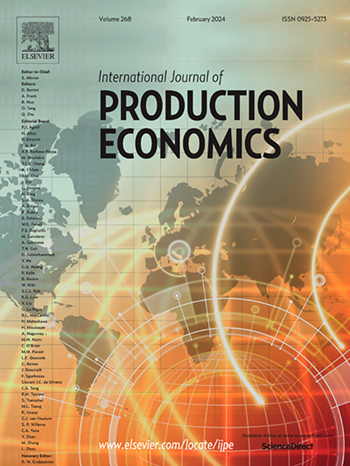需求不确定情况下的协同供应链网络设计:稳健优化方法
IF 9.8
1区 工程技术
Q1 ENGINEERING, INDUSTRIAL
引用次数: 0
摘要
本文研究了一个协作稳健供应链网络设计(CRSCND)问题,旨在通过使企业能够共同应对需求不确定性来实现经济和社会效益最大化。通过联合库存补货、共享配送中心(DC)和集中运输资源等策略,CRSCND 问题寻求在协作框架下优化工厂和配送中心的位置以及配送中心对客户的分配。为此,我们开发了两个包含预算不确定性集的稳健优化模型,每个模型都代表一种不同的风险集中政策。然后将这些模型重新表述为可求解的线性规划结构。数值实验结果证实了协作和稳健优化在降低成本方面的优势。敏感性分析表明,违规概率和高需求波动性等因素对协作和稳健性节省成本的影响最小。此外,每个稳健模型都根据具体的情景参数显示出不同的适用性。最后,我们测试了三种节约成本的分配机制,发现在涉及需求重叠的情况下,只有夏普利值法能产生最佳分配。本文章由计算机程序翻译,如有差异,请以英文原文为准。
Collaborative supply chain network design under demand uncertainty: A robust optimization approach
This paper studies a collaborative robust supply chain network design (CRSCND) problem aimed at maximizing economic and social benefits by enabling enterprises to jointly address demand uncertainties. Through strategies including joint inventory replenishment, shared distribution centers (DCs), and pooled transportation resources, the CRSCND problem seeks to optimize plant and DC locations and the allocation of DCs to customers under a collaborative framework. To address this, we develop two robust optimization models incorporating a budget uncertainty set, each model representing a distinct risk-pooling policy. These models are then reformulated into solvable linear programming structures. Results from numerical experiments confirm the cost-reduction benefits of collaboration and robust optimization. Sensitivity analysis reveals that factors like violated probability and high demand volatility minimally impact cost savings enabled by collaboration and robustness. Moreover, each robust model shows distinct suitability depending on specific scenario parameters. Finally, we test three cost-saving allocation mechanisms, finding that only the Shapley value method yields best allocations in cases involving overlapping demand.
求助全文
通过发布文献求助,成功后即可免费获取论文全文。
去求助
来源期刊
CiteScore
21.40
自引率
7.50%
发文量
266
审稿时长
52 days
期刊介绍:
The International Journal of Production Economics focuses on the interface between engineering and management. It covers all aspects of manufacturing and process industries, as well as production in general. The journal is interdisciplinary, considering activities throughout the product life cycle and material flow cycle. It aims to disseminate knowledge for improving industrial practice and strengthening the theoretical base for decision making. The journal serves as a forum for exchanging ideas and presenting new developments in theory and application, combining academic standards with practical value for industrial applications.

 求助内容:
求助内容: 应助结果提醒方式:
应助结果提醒方式:


